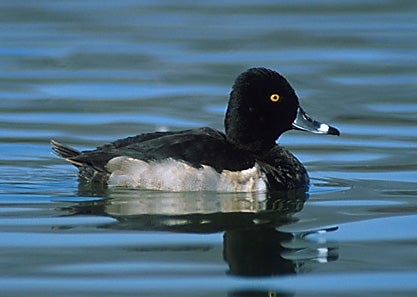SCIENTIFIC NAME:
Aythya collaris
OTHER NAMES:
Ringbill, Ringneck, Blackjack
STATUS:
Common in winter, early spring, and late fall, and uncommon to rare in other seasons in all regions. Lowest Conservation Concern.
DESCRIPTION:
“Ringnecks” are relatively small ducks, with both sexes weighing between one to two pounds. Of the two main divisions (or groupings) of North American ducks (diving ducks and puddle ducks), ringnecks are assigned to the diving duck group. As proficient divers which sometimes go to great depths to obtain food, their build is compact, and their legs are positioned further toward the back of the body, to enhance diving ability. This is in contrast to the more centered leg placement of all the puddle duck species which dive less, yet walk terrestrially more frequently. A ring-necked duck’s flight is characteristically swift and direct, with rapid wing beats. They are known for exhibiting some impressive, acrobatic air dives, which create jet-like noises during their rapid descent. From a visual standpoint, ring-necked ducks are somewhat inappropriately named, since the chestnut ring around the male’s neck (for which it is named) is barely discernible, even with the bird in hand. Winter season male “ringnecks” can usually be identified by their predominately black back and upper, frontal wing surface, and white belly feathers. The male’s head is iridescent purplish black, and somewhat angular in shape rather than well rounded. The female’s head, neck, back and frontal wing surfaces are brown and the belly is white. The bill of both sexes is a light blue or grayish color with a white “bar” or ‘ring” on the upper portion near the distal or “tip” end. Also on both sexes, the rear portion of the upper wing surface (the speculum), the undersides of the wings, and the feet are silver/gray in color.
DISTRIBUTION:
“Ringnecks” reach their highest breeding densities in the closed boreal forests (upper central portions) of Alberta, Saskatchewan, and Manitoba, apparently preferring the heavily forested areas over the prairie grasslands and the arctic region. Of those that nest in the U.S., the highest concentrations are found in forested wetlands of the Great Lakes states of Michigan, Minnesota, and Wisconsin. With the onset of the fall migration, these birds move mainly southward and eastward, with approximately 92% of the North American population ending up in the eastern half of the U.S. (Atlantic and Mississippi flyways) during winter. The largest concentrations on the wintering grounds have historically been found in Florida and Louisiana.
HABITAT:
During nesting, “ringnecks” prefer marshes surrounded by forested areas that are common in the conifer laden boreal forest region. Approximately 90% of their nests are constructed floating on the surface of the water, rather thanadjacent to the water’s edge. Natural marsh vegetation from the surrounding area is used for floating nest construction. As members of the “diver” group, “ringnecks” are frequently associated with the large water bodies of our landscape. Yet perhaps more than any other “diver” species, they are also frequently found in association with “puddle” ducks (mallard, gadwall, etc.) in the “puddler’s” preferred habitat of wooded river-bottoms or grain-planted feeding impoundments. Ring-necked ducks, therefore, exhibit a wide range of habitat usage, especially during winter.
FEEDING HABITS:
“Ringnecks” are equally diverse in their food preferences. Though proficient divers, they seem to prefer feeding in areas that are less than six feet deep. Wetland areas of this depth range can harbor both plant growth and animal matter for food, both of which are utilized by this species. As “divers”, they normally submerge completely to obtain their food. Depending upon availability, the majority of their food is generally obtained from plant sources (seeds, stems, tubers, etc.) if available, and to a lesser degree from animal matter in the form of aquatic snails, small clams, and insects.
LIFE HISTORY AND ECOLOGY:
Depending upon location, the initiation of nests by ring-necked ducks spans a period of about two months, with peak nesting period over much of their range occurring during May and June. Females lay eggs normally at a rate of one per twenty-four hour period, and attain an average clutch size of around nine eggs per nest (though ranging from five to fourteen). Females commence incubation after the last egg is laid, and continue incubation for an average of 26 days or until hatching. As is the case with all waterfowl in North America, the downy covered young are precocial (able to move about and feed for themselves) at hatching. Adult females remain with their broods until they are capable of flying, which occurs in seven to eight weeks. As the young continue development, the adult females abandon the broods and seek safety with other adult females and males on “molting areas” (areas where they complete their annual flight feather replacement, becoming flightless for a few weeks) in preparation for their fall migration.
“Ringnecks” are basically considered mid-season migrants, migrating south later than some species, yet earlier than some others. They begin their departure from the breeding grounds in early September and are normally arriving on the wintering grounds in the southernmost states by mid-October, where numbers increase gradually for four to six weeks. Whether they spend the winter in the Atlantic states, Gulf Coast states, further west, adult and juvenile “ringnecks” gradually begin departing back toward the breeding grounds during February, March, and April. Capable of breeding after their first season, both juvenile and adult females often return to the same marshes where they previously nested or hatched, to again begin the cycle of courtship, breeding, and nesting.
REFERENCES:
Bellrose, Frank C., 1976. Ducks, Geese and Swans of North America.
Wildlife Management Institute, published by Stackpole books, Harrisburg, PA. 17105.
AUTHOR:
Keith McCutcheon, Wildlife Biologist, Alabama Division of Wildlife and Freshwater Fisheries






